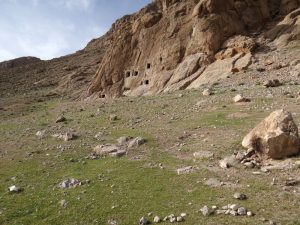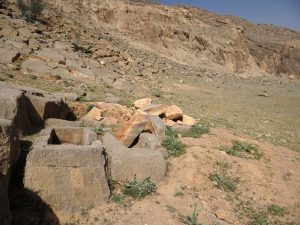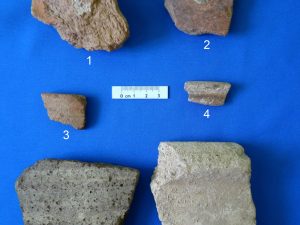Ākhōr Rōstam آخور رستم
Location: Ākhōr Rōstam is the name of a cliffside in the southeast of Persepolis, southern Iran, Fars Province.
29°53’24.69”N 52°56’28.23”E
Ākhōr Rōstam آخور رستم
Historical Period
Achaemenid/Seleucid
History and Description
Ākhōr Rōstam (Rōstam’s [Horse] Trough) is the name of a cliffside with rock-cut tombs 8 km southeast of Persepolis, in the northern part of the Korbāl-e Bālā plain. The site lies at the foot of the Kūh-e Rahmat, some 2 km northeast of the modern village of Gashak. There is no mention of the rock-cut tombs at Akhōr Rōstam either in European travelers’ accounts or books concerning the history and geography of Fārs such as Farsnāme-ye Nāseri by Hasan Fasa’i, or Āsār-e Ajam by Forsat Shirazi. The cliffside with its dakhmas is distantly located and did not attract visitors’ attention.
A total of five tombs have been hewn out of the rock at Akhōr Rōstam (figs.1 and 2). The width of their entrance varies from 0.90 to 1.5 m while the depth of the chamber ranges from 1 to 2 m (Vanden Berghe, “Monuments récemment découverts,” p. 6; Zar’e, “Ārāmgāh-e sakhrei-ye Fālūnak,”p. 149, fig. 2). One of the tombs displays a decorated façade similar to that of the Achaemenid royal tombs with a central door flanked by two engaged columns surmounted by a double-protome of bulls (figs. 3 and 4). No trace of any burial has ever been found inside the niches. At the foot of the Cliffside there is a terrace, scattered potsherd, and several cist tombs (fig. 5)
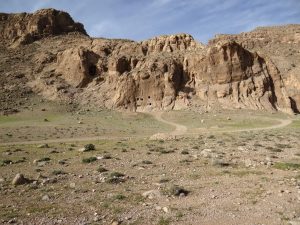
Fig.1. General view of the cliffside and niches (photo: M. T. Atayi)
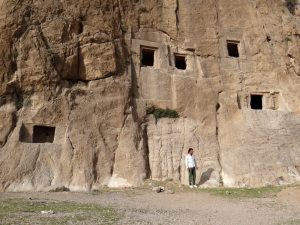
Fig.2. The cliffside with five niches (photo: M. T. Atayi)
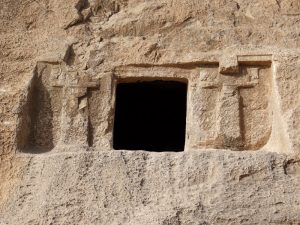
Fig. 3. Tomb with a decorated façade imitating the façade of the Achaemenid rock-cut tombs (photo: M. T. Atayi)
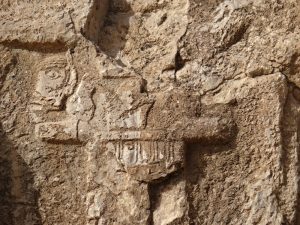
Fig. 4. Detail of the decorated façade (photo: M. T. Atayi)
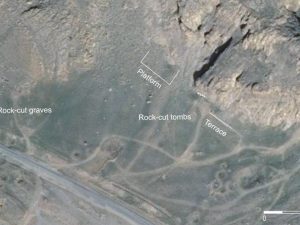
Fig. 5. Aerial view of the site with the location of the cliffside and other structures (photo: M. T. Atayi)
Archaeological Exploration
Ernst Herzfeld discovered the site in the 1920s and reported it briefly as an Achaemenid period site. Referring to plate V in his Archaeological History of Iran, Herzfeld wrote: “Near Persepolis a considerable number of tombs have been discovered of simple private people, some cut into a vertical rock, like the royal tombs, or in isolated boulders, others hollowed into the horizontal rock, always closed by huge slabs (Herzfeld, Archaeological History of Iran, p. 37, pl. V).” It was Louis Vanden Berghe who, during his surveys in Fārs in 1951 and 1952, studied the rock-cut tombs of the region of Persepolis and dated the niches at Akhōur Rōstam to the Achaemenid period (Vanden Berghe, “Monuments récemment découverts,” p. 6, pls. 4-6; Archéologie de l’Irān ancien, p. 45, pls. 61b-d). Later art historical studies showed that the niches (of which one is decorated with a double-protome of a bull in imitation of the Achaemenid royal rock-cut tombs) could date to the early phases of the Post-Achaemenid period, perhaps to the time of the Fratarakas (Von Gall, “Neue Beobachtungen…,” p. 143, figs. 13-15; Huff, “Archaeological evidence of Zoroastrian funerary practices,” p. 615, pl. VII/7). The small sounding opened by Tadjvidi at the foot of the cliffside yielded a terrace in front of rock-cut tombs (fig. 6) (Tadjvidi, Dānestanihā-ye novin, pp. 24-26).
In 1992, W. Kleiss visited the site and reported a terrace that was built of large unworked stones on the northwest side of the niches, measuring 40 × 20 m. The sherds from the surface of the site are parallel to those found from Persepolis (Kleiss, “Flächensteinbrüche und Einzelsteinbrüche…,” p. 103, figs. 25-26). The site was again surveyed by Javad Jafari in 2007, who, based on the surface potsherds, dated the site to the Achaemenid and Sassanian periods (Jafari, Barresi, pp. 5-10). On April 19, 2013, the author visited the site and reported additional tombs some 200 m to the west of the cliffside. These are cist tombs that have been carved out of the living rock; they were once covered with stone slabs (fig. 7). A collection of potsherds collected during the survey includes Achaemenid/post-Achaemenid and Sassanid shreds (fig. 8).
Recent numismatic evidence suggests that there were only five kings bearing the title of frataraka: Ardashir, Vahbarz, Vadfrādād I, Baydād, and Vadfrādād II covering a span of 20 years between 300 and 281 B.C. (the chronology has been discussed in full in Engels, “A new frataraka chronology”). There are exactly five rock-cut tombs at Akhōr Rōstam in the vicinity of Persepolis. Their artistic style, imitating Achaemenid royal tombs, and the dynasty’s chronological proximity to the Achaemenid period, based on a new high dating of the first coinage from Persepolis (Ahrabi, Löschner, and Müseler, “A New Tetradrachm of the Frataraka Vahbarz from Persepolis with a Die Flaw Turned Into a Quiver,” p. 7), strongly suggest that Akhōr Rōstam is probably the burial place of the frataraka rulers of Persia in the first decades of the 3rd century B.C.
Bibliography
Ahrabi, M., H. Löschner, and W. Müseler, “A New Tetradrachm of the Frataraka Vahbarz from Persepolis with a Die Flaw Turned Into a Quiver,” Journal of the Oriental Numismatic Society, vol. 23, 2018, pp. 7-9.
Herzfeld, E., Archaeological History of Iran, London, 1935, pl. V/1.
Huff, D., “Archaeological Evidence of Zoroastrian Funerary Practices,” Zoroastrian Rituals in Context, M. Stausberg (ed.), 594-690. Leiden: Brill.
Engels, D., “A New Frataraka Chronology,” Latomus 72, 2013, pp. 28-82.
Jafari, J., Barresi, shenāsā-yi va mostanadnegāri-ye āsār va mohavatehā-ye Sheet-e 6549I NE, unpublished report, the Persepolis library, 1386/2007.
Kleiss, W., “Flächensteinbrüche und Einzelsteinbrüche in der Umgebung von Persepolis und Naqah-i Rustam,” Archaeologische Mitteilungen in Iran, vol. 26, 1993, pp. 91-103.
Vanden Berghe, L., “Monuments récemment découverts en Iran méridional,” Bibliotheca Orientalis, vol. 10, 1953, pp. 5-8.
Vanden Berghe, L., Archéologie de l’Iran ancien, Leiden, 1959.
Von Gall, H., “Neue Beobachtungen zu den sogenannt medischen Felsgräben,” Proceedings of the IInd Annual Symposium on Archaeological Research in Iran, Tehran, 29th October – 1st November, 1973, F. Bagherzadeh (ed.), Tehran, 1974.
Tadjvidi, A., Dānestanihāy-e novin darbārey-e honar va bāstānshenāsiy-e asr-e hakhāmaneshi bar bonyād-e kāvoshhāy-e panjsāley-e Takht-e Jamshid, Tehran, 1355./1976.
Zare’, Y., “Ārāmgāh-e sakhrei-ye Fālūnak,” Bāstānpazhūhi, No. 20, 2017, pp. 147-150 (with English abstract).


